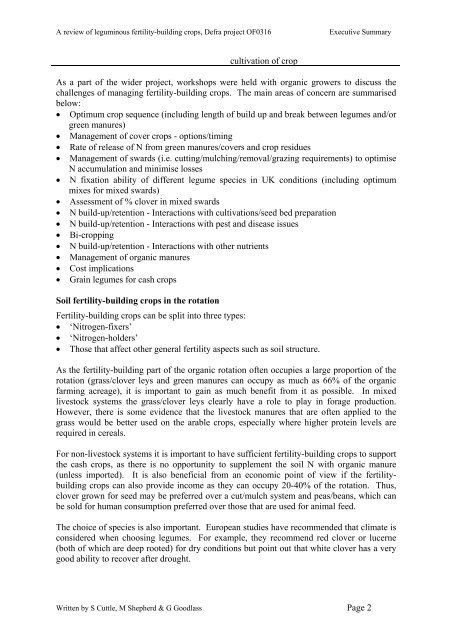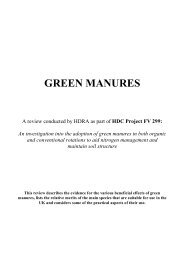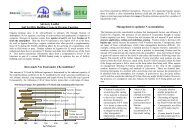A review of leguminous fertility-building crops, with particular ...
A review of leguminous fertility-building crops, with particular ...
A review of leguminous fertility-building crops, with particular ...
Create successful ePaper yourself
Turn your PDF publications into a flip-book with our unique Google optimized e-Paper software.
A <strong>review</strong> <strong>of</strong> <strong>leguminous</strong> <strong>fertility</strong>-<strong>building</strong> <strong>crops</strong>, Defra project OF0316 Executive Summary<br />
cultivation <strong>of</strong> crop<br />
As a part <strong>of</strong> the wider project, workshops were held <strong>with</strong> organic growers to discuss the<br />
challenges <strong>of</strong> managing <strong>fertility</strong>-<strong>building</strong> <strong>crops</strong>. The main areas <strong>of</strong> concern are summarised<br />
below:<br />
• Optimum crop sequence (including length <strong>of</strong> build up and break between legumes and/or<br />
green manures)<br />
• Management <strong>of</strong> cover <strong>crops</strong> - options/timing<br />
• Rate <strong>of</strong> release <strong>of</strong> N from green manures/covers and crop residues<br />
• Management <strong>of</strong> swards (i.e. cutting/mulching/removal/grazing requirements) to optimise<br />
N accumulation and minimise losses<br />
• N fixation ability <strong>of</strong> different legume species in UK conditions (including optimum<br />
mixes for mixed swards)<br />
• Assessment <strong>of</strong> % clover in mixed swards<br />
• N build-up/retention - Interactions <strong>with</strong> cultivations/seed bed preparation<br />
• N build-up/retention - Interactions <strong>with</strong> pest and disease issues<br />
• Bi-cropping<br />
• N build-up/retention - Interactions <strong>with</strong> other nutrients<br />
• Management <strong>of</strong> organic manures<br />
• Cost implications<br />
• Grain legumes for cash <strong>crops</strong><br />
Soil <strong>fertility</strong>-<strong>building</strong> <strong>crops</strong> in the rotation<br />
Fertility-<strong>building</strong> <strong>crops</strong> can be split into three types:<br />
• ‘Nitrogen-fixers’<br />
• ‘Nitrogen-holders’<br />
• Those that affect other general <strong>fertility</strong> aspects such as soil structure.<br />
As the <strong>fertility</strong>-<strong>building</strong> part <strong>of</strong> the organic rotation <strong>of</strong>ten occupies a large proportion <strong>of</strong> the<br />
rotation (grass/clover leys and green manures can occupy as much as 66% <strong>of</strong> the organic<br />
farming acreage), it is important to gain as much benefit from it as possible. In mixed<br />
livestock systems the grass/clover leys clearly have a role to play in forage production.<br />
However, there is some evidence that the livestock manures that are <strong>of</strong>ten applied to the<br />
grass would be better used on the arable <strong>crops</strong>, especially where higher protein levels are<br />
required in cereals.<br />
For non-livestock systems it is important to have sufficient <strong>fertility</strong>-<strong>building</strong> <strong>crops</strong> to support<br />
the cash <strong>crops</strong>, as there is no opportunity to supplement the soil N <strong>with</strong> organic manure<br />
(unless imported). It is also beneficial from an economic point <strong>of</strong> view if the <strong>fertility</strong><strong>building</strong><br />
<strong>crops</strong> can also provide income as they can occupy 20-40% <strong>of</strong> the rotation. Thus,<br />
clover grown for seed may be preferred over a cut/mulch system and peas/beans, which can<br />
be sold for human consumption preferred over those that are used for animal feed.<br />
The choice <strong>of</strong> species is also important. European studies have recommended that climate is<br />
considered when choosing legumes. For example, they recommend red clover or lucerne<br />
(both <strong>of</strong> which are deep rooted) for dry conditions but point out that white clover has a very<br />
good ability to recover after drought.<br />
Written by S Cuttle, M Shepherd & G Goodlass Page 2




